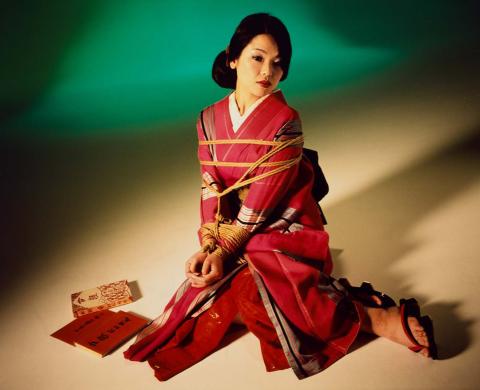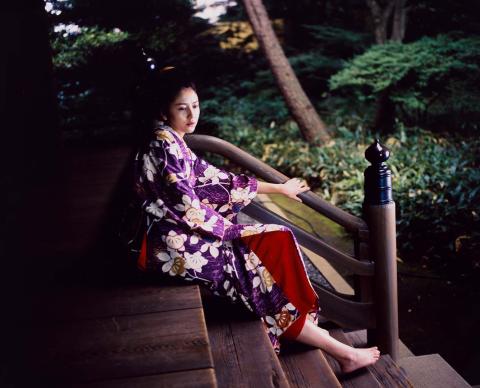ESSAY: Nobuyoshi Araki’s photographs
By Reuben Keehan
‘We Can Make Another Future’ September 2014
Emerging from the fertile photographic scene of 1960s Tokyo, Nobuyoshi Araki has become one of Japan’s best-known and most controversial contemporary artists. Highly respected nationally for his immense, intensely personal oeuvre and his innovations in the publishing, distribution and teaching of photography, he came to wider attention in the early 1990s with his provocative nudes and images of the Japanese bondage style kinbaku, or ‘tight binding’. From the outset, these works have challenged dominant social mores, epitomised by the prohibition of depictions of pubic hair, a legal oddity and carryover from an occupation-era vice ordinance that has seen the artist arrested and his exhibitions shut down on several occasions. These striking images have a rich visual provenance, drawing on the sophisticated traditions of shunga and ukiyo-e, as well as more recent developments in fashion photography and postwar erotica, including certain early works by Daido Moriyama.1 Such is the complexity of Araki’s work that while it has been criticised for exploiting and objectifying the female body, it has also proved enormously influential for the confessional ‘girl photography’ school that emerged in the mid 1990s around women artists Hiromix, Mika Ninagawa and Yurie Nagashima. Indeed, it appears submission to the binds in Araki’s kinbaku works is consensual, the binds loose enough for the models to free themselves should they feel uncomfortable.2
Importantly, these signature works have always been produced alongside other thematic studies, including Araki’s highly accessible street photography, which has documented the ever-changing urban geography of Tokyo over the course of five decades. In addition, his practice has also involved still-life photography, particularly studies of flowers; diaristic records of the artist’s daily life, including his circle of friends and colleagues, among them Daido Moriyama and Yayoi Kusama; and concentrated personal narratives of almost unbearable intimacy.3 As documents of joy, loss and grieving, these narratives are indebted to the confessional ‘I-novel’ style of early twentieth-century Japanese literature. All these strands are cross-informed, so that daily life, the natural world and the fabric of the city assume powerful erotic qualities, all operating as metaphors for the body and relationships, while his nudes, both bound and unbound, are imbricated with empathy, affection, humour and self-criticality. Araki has frequently stated that his work is themed around the duality of Eros and Thanatos (sex and death), interpreting the former as vitality and the latter as its other, the Freudian ‘death‑drive’ — inseparable forces at play in both artistic creation and human relationships.4
This set of kinbaku images is drawn from his recent bodies of work 69YK 2009 and Koki No Shashin: Photographs of a Seventy-Year-Old 2010. These late career series follow two major events in the artist’s life: surviving prostate cancer and the death of his cat Chiro, Araki’s companion since his wife Yoko succumbed to her own cancer in 1990. While hallmarks of the artist’s vibrancy abound in the images — plastic reptiles, an appearance by his favourite model and muse Kaori — the significance of developments in his life is registered in a slight tonal shift, as well as the regard with which the subjects return or otherwise deflect the gaze of the photographer. In one cool-toned picture, a kimono-clad woman is photographed from the side, her attention directed to something beyond the camera and her immediate environment. Here, the typically breezy, amiable tone of Araki’s work is momentarily interrupted by both an image and a sensibility of contemplation. Given, as he confesses, to sentimentality, Nobuyoshi Araki’s comments on these works suggest the advent of a melancholy, prompted by reflections on his own mortality and tempered with an embrace of nostalgia, which is at once life‑denying and life-affirming.
Endnotes
- Moriyama’s 1972 series Mayfly (Haga Shoten, Tokyo, 1972) is a clear precursor.
- Nobuyoshi Araki has said: ‘When I tie-up women, I tell them “I’m binding your heart, not your body”. A woman can slip out of my bondage. It doesn’t have to be accomplished.’ Artist statement [publicity material], ‘Nobuyoshi Araki: Hana Kinbaku’, Taka Ishii Gallery, Tokyo, 25 May – 21 June 2008.
- Araki’s most intimate works are his photo-essays Sentimental Journey (privately published in an edition of 1000, 1971), which candidly documented his honeymoon with his new wife Yoko, and Sentimental Journey/Winter Journey (Shinchosha, Tokyo, 1991) on Yoko’s illness and death, and Araki’s mourning. This couplet was mirrored in Chiro, My Love (Heibonsha, Tokyo, 1990) on his beloved cat, who became Araki’s only companion following Yoko’s death, and Sentimental Journey/Spring Journey (Rat Hole Gallery, Tokyo, 2010) on Chiro’s death.
- As Akiko Miki has noted, a particularly perceptive critic once remarked that Araki’s work is like looking ‘under a stone, the proper but false surface of the town, to find a real world of swarming life forms underneath’; see Akiko Miki, ‘The photographic life of Nobuyoshi Araki’, in Akiko Miki, Yoshiko Isshiki and Tomoko Sato (eds), Nobuyoshi Araki: Self, Life, Death, Phaidon Press, London and New York, 2005, p.17.
Connected objects

69YK 2009
- ARAKI, Nobuyoshi - Creator
Metadata, copyright and sharing information
About this story
- Subject



